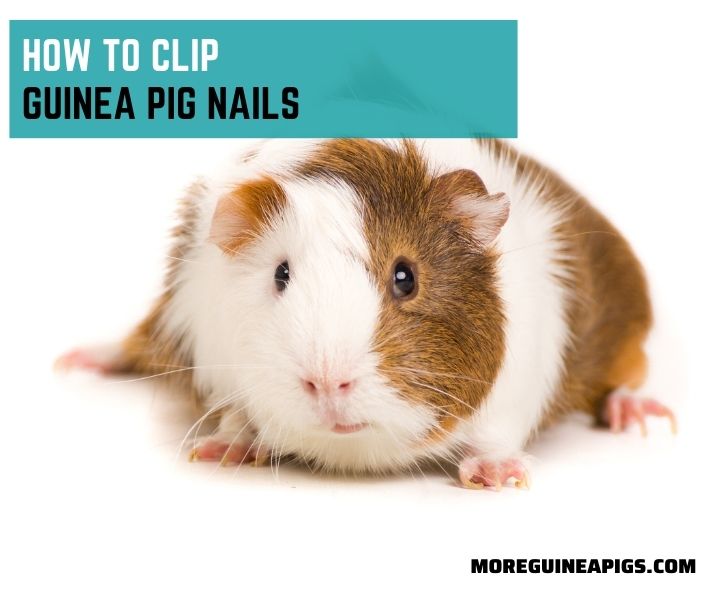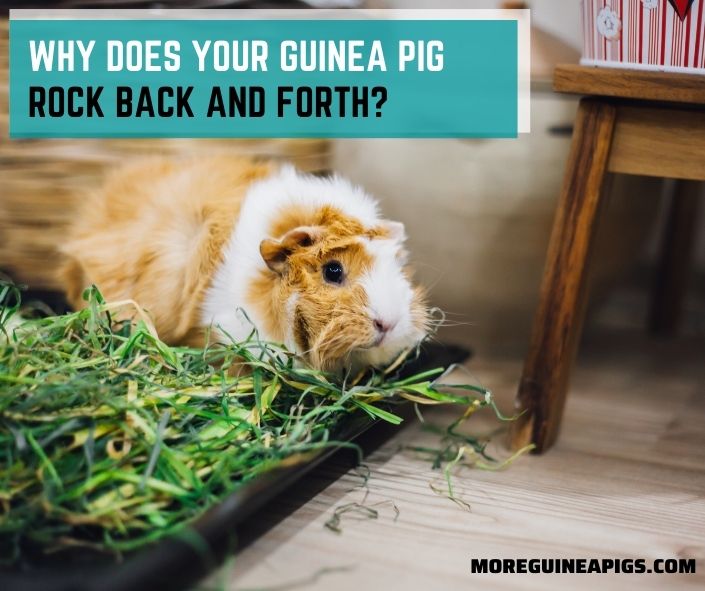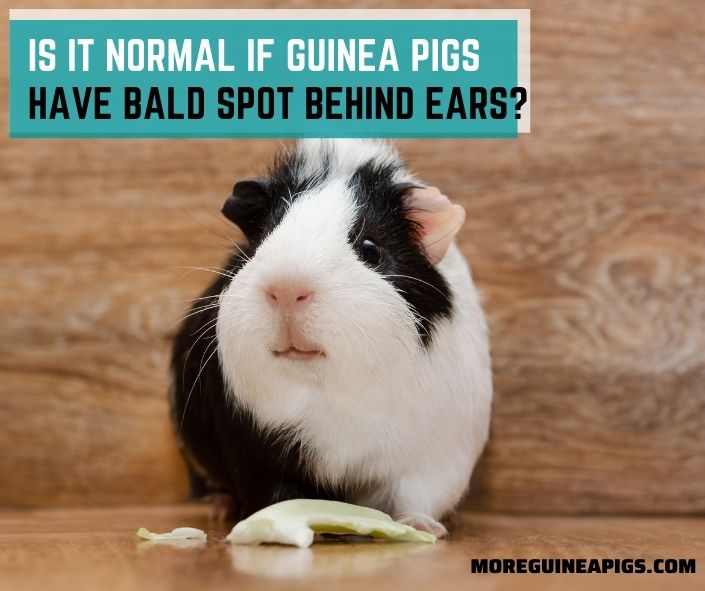Chinchilla Vs Guinea Pig as Pets
Are you facing a tough decision on which animal companion to choose between, chinchilla vs guinea pig? Chinchillas and guinea pigs are pocket-friendly animals, and they make excellent pets in the household.
Understanding their characteristics, personalities, needs, and preferences are imperative for keeping them happy, comfortable, and healthy. This is because both have unique features despite having few things in common.
Let us dive into this article for more details as I will shed some more light on the similarities and differences. After that, you will be in a position to decide on which one to keep in your household.
Chinchilla Vs Guinea Pig as Pets
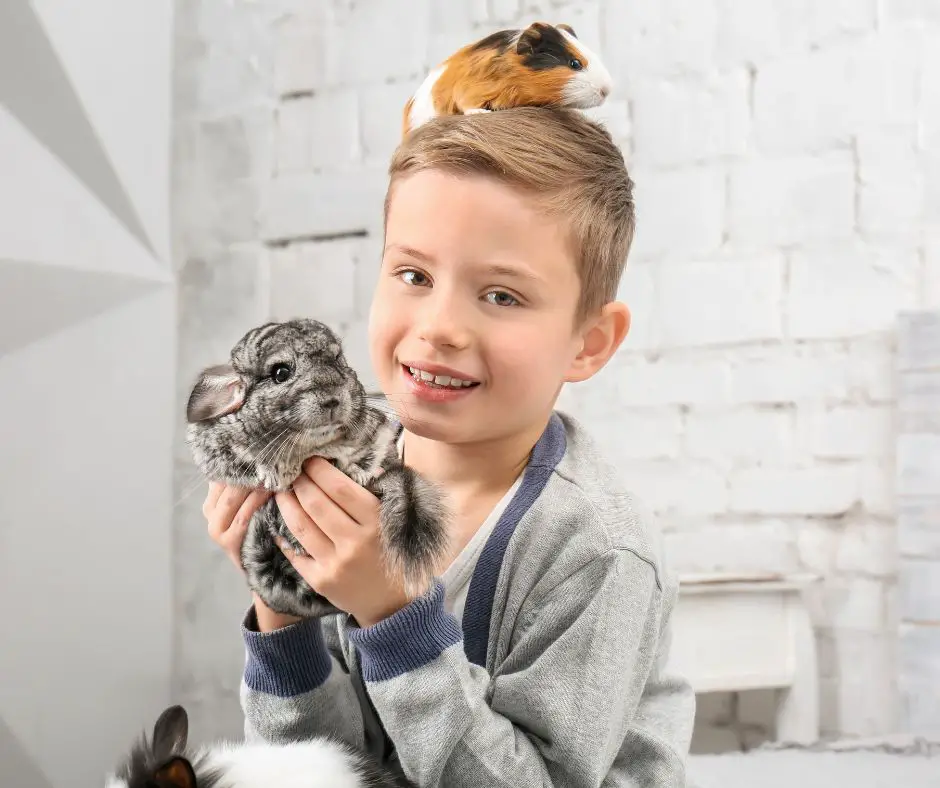
Chinchillas and guinea pigs belong to the same rodent family; as a result, they share a few things in common, for example, the habitat.
However, there is a significant difference between the two regarding their personality and size. You will differentiate this when you interact with them often.
For instance, a chinchilla is lighter than a guinea pig. An adult chinchilla weighs around 1 – 3 pounds, while an adult guinea pig weighs about 1.5 – 2.6 pounds. The chinchilla baby weighs 30 – 80 g, while the guinea pig baby weighs 60 – 115 g.
In addition, each has its own unique personality. A chinchilla is curious and temperamental, while a guinea pig is always calm and easy-going.
Dozens of experiences you will counter with chinchillas and guinea pigs. Below is detailed information you need to arm yourself with between chinchilla and guinea pig so that you’re well informed.
| Information | Chinchilla | Guinea Pig |
| Origin | South America | Andes of South America to Europe |
| Average weight (baby): | 35 – 80 g | 60-115g |
| Average length (adult): | 9-15 inches | 8-12 inches |
| Average weight (adult): | 1 – 3 pounds | 1.5 – 2.6 pounds |
| Lifespan: | 10-15 years | 5-8 years |
| Exercise: | 1-2 hours a day | 3-4 hours a day |
| Active | crepuscular and nocturnal | mostly diurnal |
| Color: | diversity | Diversity |
| Grooming needs: | Minimal | Moderate |
| Owners-friendly: | Yes | Yes |
| Other pet-friendly: | Not usually | Sometimes |
| Behavior | in herds (from 14 members up to 100) | in herds (from 10 or more) |
| Trainability: | Moderate | Easy |
| Cost | $80 – $150 | $25-$50 |
Overview: Origin, Appearance, and Lifespan
Similarly, chinchilla and guinea pig are ancient species that originated from South America in the Andes Mountains of Peru, Chile, and Bolivia. However, both had different habitats.
Chinchilla comes from the semi-arid top in South America in Andres Mountains. At the same time, guinea pigs cut across the tropical areas of the Andes Mountains, varying from moist savannah to thorn forest and scrub desert as well.
In appearance, both have a variety of colors, e.g., brown, black, white, beige, sapphire, gray, etc. When you hold chinchilla and guinea pig together, you will note that chinchilla are small in size, have a tail, and short-haired
Chinchilla also has a thick coat protecting them from pests like mice, fleas, and other elements. In contrast, guinea pigs are tailless, large, typically long-haired, and have a thin coat.
Chinchilla can also live for an average of 10 – 15 years, while guinea pigs can live for 5 – 10 years. As a result, chinchillas have a longer lifespan than a guinea pig, hence a long-term partner.
Diet
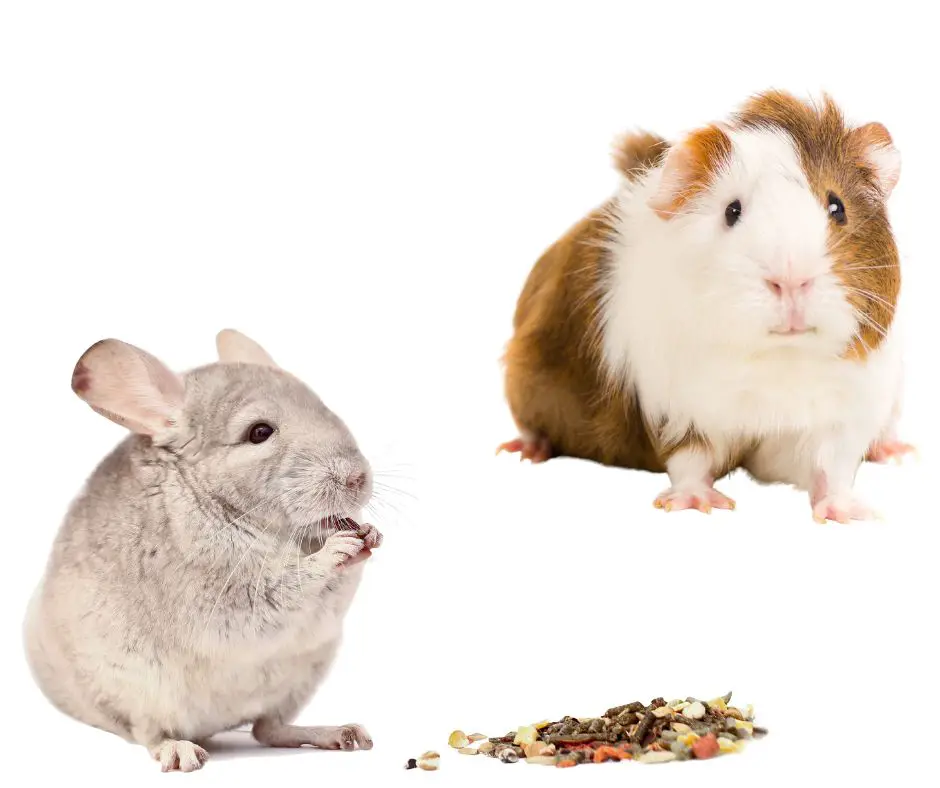
Generally, both chinchilla and guinea pigs are herbivores, and they eat plant matter. However, they have different nutritional needs for their body. Chinchilla eats plant matter rich in fiber.
Its digestive system can manage a lot of fiber content in the diet. This is useful since it requires a lot of fiber to remain healthy and active. Its diet consists of timothy hay.
Chinchillas have a sensitive stomach; they cannot eat many fresh vegetables, sugary treats, and fruits. The pellets should not have seeds or treats or any other thing inside.
Chinchilla loves goji berries, dried flowers, fruit tree branches, and rose hips.
Guinea pigs require a diet rich in vitamin C and fiber. Their body cannot make/ synthesize vitamin C. Their diet comprises green soft leafy vegetables, hay, fruits, herbs and treats, and pellets customized for it.
Guinea pigs are fond of eating kales, bell peppers, carrots, leafy greens, hay, apples, etc. It also needs access to enough freshwater since it often drinks water.
Personality and Temperament
Chinchilla is a crepuscular and nocturnal animal; they are usually active around morning twilight and before nightfall. Hence, it will always keep you at night. And they are also not noisy.
Chinchilla, too, is curious and energetic; as a result, it will delve into everything around it. That is why it will always find itself falling into mischief.
Chinchilla also has a nervous temperament and exhibits a defensive behavior called “fur slip,” whereby it will shade a large patch of fur to slip out of your grasp. It likes to be quiet and shy.
In contrast, guinea pigs are sweet, temper, calm, and docile animals. However, they will nip or bite you and slip from your hand to the floor when you mishandle them. Hence, less temperamental
Fortunately, they are primarily diurnal; are primarily active during the day; hence they won’t disturb you at night while you’re asleep. Guinea pigs are also noisy or vocal, like making squeaks and sounds to cage mates and owners.
Also read: 11 Guinea Pig Behaviors To Help You Understand More About Them
Care Requirements
To protect them from suffering from heatstroke or cold stress, both chinchillas and guinea need to be housed indoors free from extreme weather conditions and temperatures. They both tolerate a certain range of temperature variations.
Likely, they both need a wire cage with a solid bottom which should come from any other durable materials apart from flimsy plastics. The cage should be easy to clean and accessible.
Also read: Complete Guinea Pig Care Guide

House (Space)
Each has individual needs; for instance, the right cage for a chinchilla is at least 3 feet tall and 2 feet wide to provide enough space to jump and exercise.
Guinea pig requires a cage that is 3 feet long and 18 inches wide. This will be enough to do an exercise for 3 – 4 hours a day. Both chinchilla and guinea pig require beddings; fleece pads favor them more.
Also read: Top 5 Guinea Pig Cages & 7 Factors To Make Perfect Enclosure
Bath
You should neither bathe your chinchilla nor expose its body parts to water. To make it clean, you will only provide a bowl of dust twice a week. When wet, fungus will grow on the coat.
A dust bath is a fine powder, and it originates from volcanic ash, where it acts like dry shampoo and oil absorbent. It will make the chinchilla look fluffy and fresh.
In contrast, the guinea pig is bathed once in a while because it’s an immaculate creature that often grooms itself. Cavies secrete natural oils on their fur and skin to keep their bodies perfect.
But should it get dirty, you will need a few inches of the lukewarm water bath in the tub or sink. Eventually, dry the pig with a towel to keep warm and dry.
Just like chinchilla, cleaning a guinea pig frequently will make them contract respiratory infections.
Also read: How To Bathe a Guinea Pig?
Groom
Both chinchillas and guinea pigs sometimes get dirty during outdoor exercise; as a result, hence, it is mandatory to groom them. Luckily, they are excellent at keeping themselves clean.
These rodents require minimal grooming, but you should make a schedule to brush them, clip their nails, trim their hair (where necessary), clean their ears, etc. Chinchilla’s nails don’t grow too long, but you can cut them less often.
Brushing the hair helps remove dead fur and brighten up the animal’s appearance. It gives the two rodents a polished and smooth look.
Chinchillas and guinea pigs are naturally neat rodents that self-groom frequently. Hence, they only need very little supplemental grooming, especially healthy pets. You can choose to groom them every few weeks.
Also read: The Complete Guide about Guinea Pig Grooming
Ware Manufacturing Small Animal Grooming Kit
Dental Care
Dental care is a primary prerequisite in both chinchilla and guinea pigs, their teeth wear out sometimes, and failure to check will cause dental problems for them.
For instance, if the chinchilla is not wearing the teeth themselves, you will chip in to assist in trimming the teeth but in line with the vet’s advice. Annual teeth checkups are helpful to ensure they remain clean, fresh, and healthy.
In the guinea pigs, you should provide them with much fresh grass, hay, vegetables, and herbs to maintain a healthy and clean dental. You will ensure it gets professional care as well.
To keep the teeth of chinchillas and guinea pigs fit, you should provide materials and toys for gnawing and chewing, such as bone toys and wood toys.
Also read: 9 Best Guinea Pig Toys
Nails
Unlike other rodents, chinchillas do not have particularly long claws on their feet. They tend to keep their nails short.
A chinchilla does not need the owner’s help in cutting or trimming nails. If an owner tries to help them, they can injure their toes. On the other hand, Guinea pigs need regular nail trimming at least once a month.
This prevents damage to the skin because nails that are too long tend to curl and can grow into their footpads, thereby causing open wounds on the feet.
Also read: How To Clip Guinea Pig Nails
Health Problems
Neither chinchilla nor guinea pig requires regular vaccination nor any other regular medical procedures. But semiannual health checkups are vital to keeping them safe from any underlying common sickness.
However, each has its health problems that it is prone to; for example, chinchillas are susceptible to bloat, dental disease, bumblefoot, and respiratory diseases.
On the other hand, guinea pigs are susceptible to urinary tract infections, parasites, skin problems, and scurvy. Fortunately, proper care and management will eradicate the disease-causing microorganisms.
Also read: 8 Disorders and Diseases of Guinea Pigs
Costs
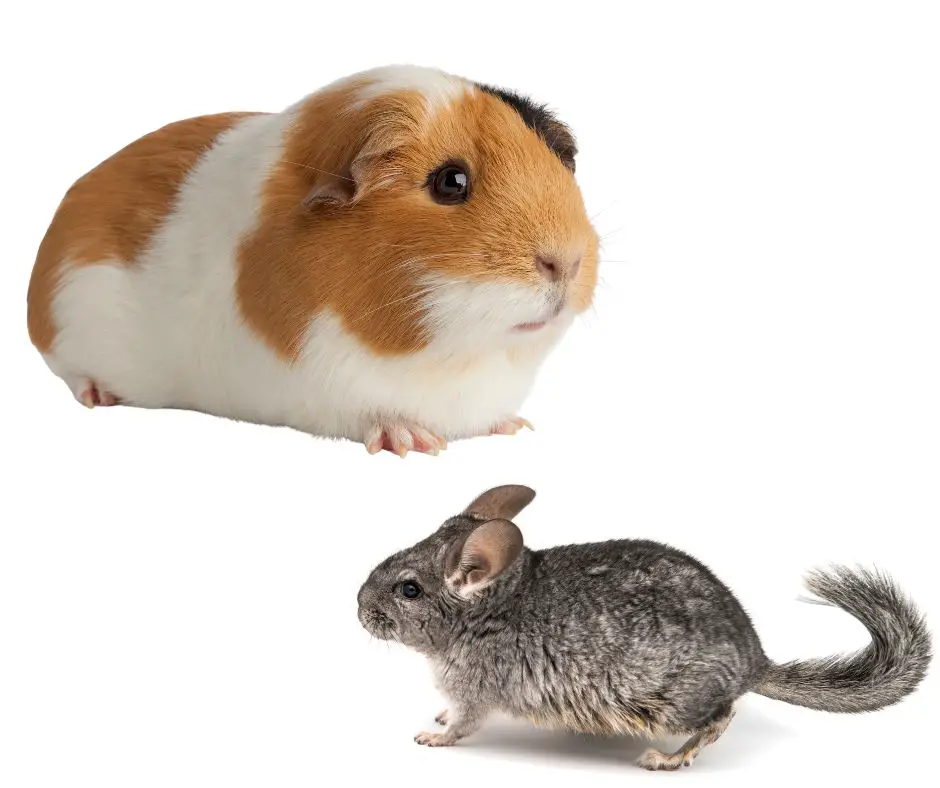
Keeping a chinchilla is relatively cheaper in food and care except for vet fees than a guinea pig. The chinchilla costs from $80 – $150 from breeders, where colored ones are slightly higher.
Besides, the chinchilla cage and accessories and vet fetch high prices. On the other hand, a guinea pig is relatively cheaper than a chinchilla. The initial cost of buying a guinea pig is $25 – $50 from a professional breeder.
The total initial cost of keeping a guinea pig varies from $100 – $500, including beddings, food, cage, toys, and water dispensers. It’s easy and cheap to offer training to guinea pigs and chinchillas.
Also read: How Much Are Guinea Pigs?
Suitability: Best for Whom?
Chinchilla is suitable for busy households, and handling it requires you to have enough experience and not kids even though its management is straightforward.
A Guinea pig can suit children, adults, and households with other pets. They are easy-going sometimes with other pets. Guinea pig is fun though it requires a lot of attention and care.
Can Chinchillas and Guinea Pigs Live Together?
No. chinchilla and guinea pig are incompatible and should not live in the same cage because they have different nutritional requirements and risks fighting each other.
You don’t want your cavy to accidentally eat a chinchilla’s food or even the reverse to happen. Guinea pigs enjoy staying in the company of each other, but not with other animal species.
These two species can also thrive well when living alone, but you can house them with their counterparts only to encourage social interaction and have playmates.
Which Is Better: Chinchilla or Guinea Pig?
A chinchilla and a guinea pig have unique characteristics which will melt your heart, but choosing the best among the two will depend on your pocket, tastes, and preferences, as well as on other factors.
For instance, chinchillas are long-living pets and provide many years of companionship than guinea pigs. And this calls you for a long-term commitment.
Both pets have pros and cons (as discussed above in the overview), which will help you make a sound judgment. Go for the pet that you can handle and maintain with ease.
Wrapping Up
In a nutshell, chinchillas and guinea pigs can make excellent pets for your household. They are both entertaining, sportive, and attractive animals.
Choosing between the two will depend on your individual needs and desires of your heart, since they both have significant differences, which makes each of them worthwhile.
Whether you settle on keeping a chinchilla or guinea pig, always make sure to provide the proper care and diet, purposely to keep them happy and healthy.

